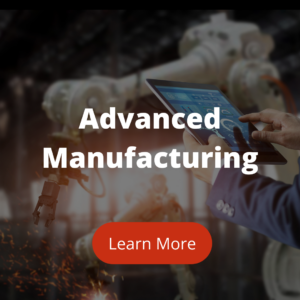Automation is relieving humanity of mundane, repetitive tasks. Whether it’s a computer program automating a part set up in Fusion 360 or a robot lifting a heavy metal part and placing it somewhere else on a factory floor, the idea is the same: let’s make work safer and less tedious for people. At first glance, a small manufacturer may not think that robotics for manufacturing is a possibility for their business, but with recent advances, it’s time for businesses of all sizes to consider how automation and robots can help them get the job done.
The Evolution of Robotics
60 years ago, George Devol and Joseph Engelberger unveiled Unimate, the first industrial robot, on an assembly line at a General Motors plant in New Jersey. Within a few years, the 2,700 lb. robotic arm was being mass-produced and installed as a die caster in factories around the country. In 1966, Unimate even appeared on the Johnny Carson show, where it poured the host a beer and conducted the band.
In 2022, robots can still pour you a beer—and do a lot more. Today’s industrial robots have become highly adaptable, affordable, and easily programmable. It used to be that only the largest and wealthiest corporations could afford to deploy industrial robots, but rapid advances in technology, the development of small and collaborative robots (cobots), plus the emergence of a used robotics marketplace have brought costs down significantly. Small to mid-level companies have begun taking advantage of the relatively low price, with some robots selling for $27,000.
The robots are coming—but in a good way. Let’s examine what advantages robots bring to manufacturing, what exactly they do, and what the future of industrial robotics looks like.
Why Robots in Manufacturing? Let’s Talk Advantages.
Robots have many uses in manufacturing. Perhaps the biggest advantage they provide right now is addressing the growing labor shortage. According to a recent survey, 77% of manufacturers are having a hard time attracting and retaining skilled workers, and finding talent is 36% harder than it was just four years ago. By the end of the decade, manufacturing is looking at more than two million unfilled jobs. As a result, manufacturers are turning to robots for help—robot sales increased 37% over the last year alone.
But what specific advantages do they provide? Why should manufacturers embrace automation now? Here are just a few reasons:
- Safety. The most important benefit is also the most obvious: removing humans from dangerous situations means fewer humans will be harmed.
- Quality. Human error is one of the biggest hindrances to product creation. Robots reach levels of accuracy and precision that humans simply can’t achieve.
- Cost. Over the last ten years, the cost of an average starter industrial robot arm has dropped almost 60%, from $46,000 to $27,000, and is projected to get as low as $11,000 by 2025.
- Efficiency. Because robots can run 24/7, factories can go fully automated if they choose—working faster and around the clock to keep up with demand.
- Sustainability. With computer-powered precision, less material is wasted in the creation of products, enabling sustainable manufacturing.
- Re-shoring. Manufacturing is coming home. Through greater efficiency and cost savings, robotics is helping to bring jobs back to the United States.
What exactly are industrial robots and what do they do?
We all know what a robot is, right? A machine that operates automatically or by remote control. If you’re looking for the technical definition, here’s one from the Robotics Industries Association:
“An industrial robot is a reprogrammable, multifunctional manipulator designed to move materials, parts, tools, or specialized devices through varied programmed motions for the performance of a variety of tasks.”
In manufacturing, most robots are “general purpose,” meaning you can reprogram them for whatever the day has in store. They help automate and streamline aspects of the manufacturing process. Recently, new developments in machine vision and sensor technology along with offline programming have allowed some companies to move to “lights-out manufacturing,” which means they’re fully automated and run 24 hours a day.
The Spectrum of Robotics in Manufacturing
You could fit most of what industrial robots do into three categories: material handling, processing operations, and assembly and inspection.
Material Handling
This basically means the robot is loading and unloading machines and bringing parts and materials from one place to another. Often this is simple, and an easy way to replace manual labor since it involves the same repeatable process. It also includes palletizing, where a robot loads up pallets just before they are shipped out. This requires robots to have different adjustable tools (or grippers) that can be attached to the end of their arm, which is called EOAT (end of arm tooling). EOAT is also a key feature of processing operations.
Processing Operations
A robot involved in processing operations uses a tool (on the end of its arm) to perform a task on a part. The most common use is in the automobile industry, where spot welding robots complete the assembly of car bodies. Advances in design have allowed robots to reach into confined spaces and perform intricate welding that would be difficult or impossible for a person.
There are about as many uses for processing operations robots as there are tools. Other common applications include spray-painting, material removal (polishing, grinding, buffing, etc.), and injection molding.
Assembly and Inspection
Need to assemble a part? Or join multiple parts together? You can use a robot for that. Many manufacturers have changed the design of what they make to maximize the precision and speed of automated assembly. What was once a screw- and nut-fastening job for manual labor is now an automated process with snap fits.
After the part is assembled, it’s time for inspection—a crucial part of the manufacturing process. It’s the last chance to find errors, but you don’t want the bottlenecks that can occur by trying to check every single part by eye. You also don’t want to miss anything, so random inspections may not cut it either. Enter robots. With robotic inspection, the robot places a sensor or probe next to the completed part and takes readings. It then uses software to quickly determine if the part is up to specs or not, or it can send the measurements to an inspection engineer for human approval.
Coexisting with Cobots
Collaborative robots are a type of robot designed to work alongside humans. They’re much smaller than industrial robots and have enhanced sensors. They don’t require cages, making them a popular choice among smaller manufacturers who work in smaller spaces or older factories.
Cobots are meant to support and augment the work humans do, not replace people. That immediately makes them popular with workers. Workers can stay on the job for years longer, helping to solve the shortage of skilled workers. In addition, programming a cobot can be as simple as moving its arm around for a few minutes. No more complicated coding. Having a mobile, small, easy-to-program cobot around means more flexibility—and in today’s manufacturing landscape that’s a big bonus.
What’s Next
What’s coming next for industrialized robotics in Industry 4.0?
Don’t think big. Think small.
Robots and cobots made of soft materials will allow for closer work with humans and will have the adaptability and flexibility to change shape and utilize non-linear mechanics. With the ability to design and print in 3D, soft robots are the next wave, and could soon be slithering their way to a factory near you.
A less sexy, but no less important development is that of open-source software and industry guidelines. This will have a major impact on enhancing interoperability. A common foundation for robot development means easier deployment. Easier deployment means easier adoption. So not only is it good for business, but it’s also becoming easy to adopt—and getting more affordable with each passing day.
Here are five other examples of innovation in industrial robots.
60 years after Unimate, robots have cemented their place in manufacturing. Whether you make tennis shoes or Teslas, there is an automation solution that can help you safely streamline operations and processes. Make this year the year you embrace automation.

